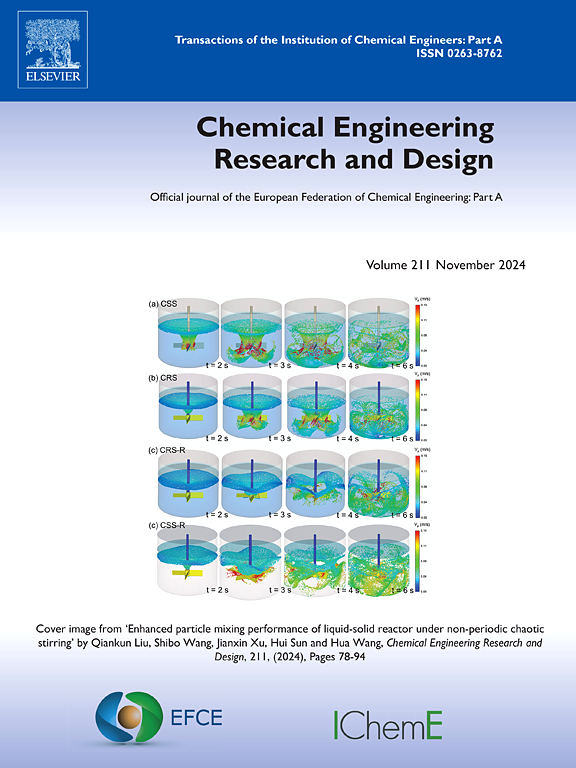树脂催化反应模型整合了催化剂溶胀和位点可及性:在缩酮合成中的应用
IF 3.7
3区 工程技术
Q2 ENGINEERING, CHEMICAL
引用次数: 0
摘要
结合树脂溶胀指数的动态变化、内部传质阻力、非理想液体混合物以及有限位点的可及性,建立了树脂催化反应的新型数学模型。在考虑水吸附的情况下,采用了 Langmuir-Hinshelwood-Hougen-Watson (LHHW) 机制。成功验证了乙醇(R² = 0.96)和无溶剂体系(R² = 0.99)中的溶酮合成实验数据。共聚模型利用 Karam 和 Tien 算法估算了树脂的溶胀性和可及性特征,得到了与甘油转化率相关的线性溶胀数据(R² = 0.9995)。将这些线性方程纳入催化模型表明,由于孔隙率增加和曲折度降低,甘油转化率可比未溶胀体系高出四倍。催化位点上的吉布斯自由能分别为 4.7 ± 0.9 kJ mol-1(有溶剂)和 12.1 ± 0.6 kJ mol-1(无溶剂),313 K 时的反应速率常数为 109 s-1。本文章由计算机程序翻译,如有差异,请以英文原文为准。
Resin-catalyzed reaction modeling integrating catalyst swelling and sites accessibility: Application to solketal synthesis
A novel mathematical model for resin-catalyzed reactions, incorporating dynamic variations in the resin's swelling index, internal mass transfer resistances, non-ideal liquid mixtures, and limited site accessibility, was developed. The Langmuir-Hinshelwood-Hougen-Watson (LHHW) mechanism, considering water adsorption, was used. Validation with experimental solketal synthesis data in ethanol (R² = 0.96) and solventless systems (R² = 0.99) was successful. A copolymerization model estimated the resin's swelling and accessibility features, using Karam and Tien’s algorithm to obtain linear swelling data correlated with glycerol conversion (R² = 0.9995). Incorporating these linear equations into the catalysis model indicated glycerol conversion could be up to four times higher than in unswollen systems due to increased porosity and decreased tortuosity. Gibbs free energies of 4.7 ± 0.9 kJ mol−1 (solvent) and 12.1 ± 0.6 kJ mol−1 (solventless) were found, with a reaction rate constant of 109 s−1 at 313 K on the catalytic sites.
求助全文
通过发布文献求助,成功后即可免费获取论文全文。
去求助
来源期刊

Chemical Engineering Research & Design
工程技术-工程:化工
CiteScore
6.10
自引率
7.70%
发文量
623
审稿时长
42 days
期刊介绍:
ChERD aims to be the principal international journal for publication of high quality, original papers in chemical engineering.
Papers showing how research results can be used in chemical engineering design, and accounts of experimental or theoretical research work bringing new perspectives to established principles, highlighting unsolved problems or indicating directions for future research, are particularly welcome. Contributions that deal with new developments in plant or processes and that can be given quantitative expression are encouraged. The journal is especially interested in papers that extend the boundaries of traditional chemical engineering.
 求助内容:
求助内容: 应助结果提醒方式:
应助结果提醒方式:


